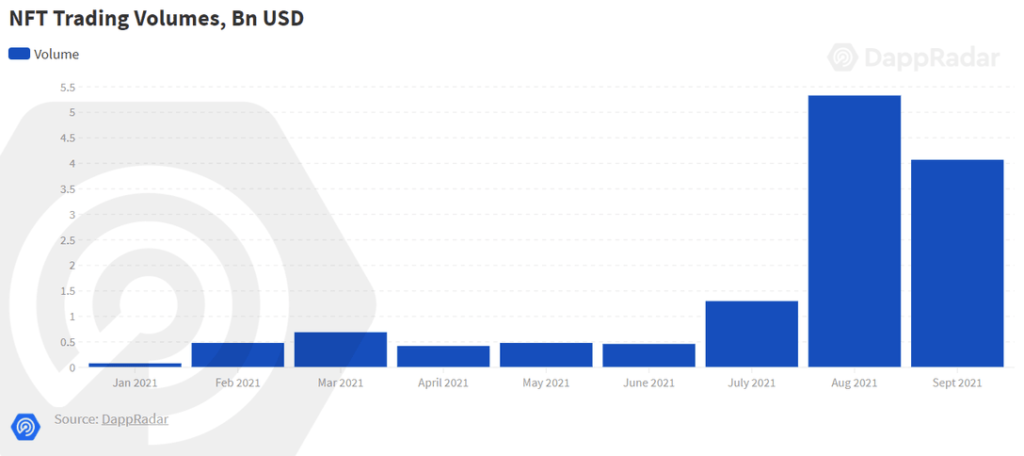Non-fungible tokens (NFTs) are all around us. From art and music to gaming and movies, these digital assets are selling for millions of dollars. They are digital assets with distinct data recorded in smart contracts – a piece of code designed to carry out a set of instructions. Unlike banknotes, which can be exchanged for another, smart contracts make NFTs unique and unable to be directly replaced by another token.
Bought and sold online, often with cryptocurrency, NFTs are usually encoded with the same underlying code as many cryptos. Having been around since 2014, they’re gaining infamy because of their increase popularity amongst different industries. In 2021 alone, NFTs were worth $41 billion, a number that’s close to the total value of the entire global fine art market.
NFTs are usually one of a kind and have unique identifying codes. However, a significant number of them, especially during the initial stages, comprise digital creations that already have a presence elsewhere. Examples include well-known video clips from NBA games or digitized versions of art that’s already circulating on Instagram.
Yet, the question remains: are they worth the hype?
How are NFTs used and how do they work?
NFTs can be used to distinguish digital assets from one another to determine their value or scarcity. They represent anything from virtual land parcels to artwork and ownership licenses. NFTs can be bought and sold in a number of places such as OpenSea and Rarible, two of the most popular marketplaces.
In conjunction with their associated smart contracts, NFTs enable the inclusion of specific attributes like owner identity, rich metadata, and secure file links. Their strength lies in establishing guaranteed digital ownership, a significant advancement in our digital society, and extends blockchain’s trustless security to varied asset ownership and transactions.
Blockchain technology has faced ongoing challenges, and this holds true for the development of NFTs, their protocols, and smart contract systems. The creation of distributed applications and platforms for managing and generating NFTs remains a complex task. Another obstacle is the establishment of a standardized approach. The diverse landscape of blockchain development with individual projects calls for unified protocols and interoperability to achieve success.
NFTs taking flight
2020 marked the year when NFTs hit the runway, with the introduction of Rarible, created by Alexei Falin and Alex Salnikov. Rarible distinguishes itself from conventional NFT exchanges like OpenSea or SuperRare because their NFTs are decentralized. In decentralized exchanges, authority of the platform—how it operates—is delegated to holders of governance tokens, such as Compound (COMP) price.
The only way to obtain governance tokens was through purchasing them on crypto exchanges or NFT platforms. And while their intended purpose is for governance, many holders utilize them primarily for profit generation.
NFTs and art
The NFT landscape frequently ventures into the domain of crypto art, where the creative and rebellious nature of the crypto world finds its perfect expression. Artists have flocked to NFTs in large numbers to seize the opportunity they provide for genuine digital ownership, finally giving people a compelling reason to invest in digital art.
Nonfungible.com, a metrics platform monitoring the NFT industry, reveals that the latter part of 2021 witnessed a surge in crypto art’s popularity. This coincided with DeFi’s boom into the market and Bitcoin’s surge.

While NFTs unite artists, the world of NFT art is as eccentric as it can get, and 2021 witnessed even stranger developments. Some individuals entered the world of crypto art to transform money into art, while others discovered an audience willing to pay staggering sums.
For instance, renowned digital artist Mike Winklemann (often referred to as ‘Beeple’) combined 5,000 daily drawings to produce one of the most notable NFTs of 2021, titled ‘EVERYDAYS: The First 5000 Days.’ This extraordinary piece set a record-breaking sale at Christie’s auction house for $69.3 million. Beeple is also known for his work with musicians like Flying Lotus, Nicki Minaj, and Justin Bieber.
In October 2020, artist Ben Gentilli achieved a remarkable sale at Sotheby’s, an influential art auction, by selling an NFT-linked artwork titled “Block 21” for $131,250. This piece featured a “digital portrait” of Bitcoin’s creator, Satoshi Nakamoto. The circular panel (one of 40) contained hundreds of thousands of digits comprising Bitcoin’s original code. An associated NFT displayed the piece’s coordinates, which are currently located in New York.
Other notable artists who ventured into the NFT realm in 2020 include José Delbo, an 87-year-old Argentinian comic book artist. He sold a collaborative piece with Canadian crypto artist Trevor Jones for $111,377 in Ethereum (ETH).
NFTs and luxury brands
The fashion industry is at the forefront of showcasing the diverse applications of NFTs, highlighting their evolution beyond traditional art domains. Notable instances include Nike’s venture into the metaverse with NIKELAND, Tiffany & Co.’s exclusive NFT series, and Gucci’s immersive endeavors in the digital space.
Nike
One of the most popular athletic footwear and apparel corporations, Nike, has been at the forefront of the fashion industry. In 2021, they partnered with online gaming platform Roblox to launch NIKELAND. Athletes and gaming enthusiasts can interact in the immersive 3D space and share experiences, play sports, establish connections, showcase virtual apparel, and partake in various exciting online activities.
NIKELAND ensures a collaborative virtual environment, motivating its community to become creators and shape the future of sports in the metaverse. This positions Nike to potentially lead a new era in sports.
But that’s not all the well-established sportswear company is doing. That same year, the apparel giant launched a new Web3 platform, .SWOOSH, designed to give consumers a new community experience and the chance to co-create the future of Nike. Consumers can:
- build their collection, display, trade, or wear their Nike Virtual Creation(s) in video games and other immersive experiences.
- unlock special access to products, experiences, and content as well as being able to pre-order upcoming drops.
- engage with .SWOOSH members, participate in community challenges, and seize opportunities to collaboratively shape the future of Nike Virtual Creations.
- join virtual or in-person events to connect with Nike athletes, designers, and enthusiasts who actively influence culture.
In December 2021 Nike revealed its acquisition of RTFKT, a prominent brand utilizing digital innovation for the creation of online collectibles blending culture and gaming. This move represents Nike’s ongoing initiative to expand its presence in blockchain, the metaverse, and cryptocurrency.
Tiffany & Co.
One of the most prominent luxury brands, Tiffany & Co. dove into the NFT waters last year revealing its limited NFT series NFTiff, a collection of 250 custom jewel-encrusted pendants for holders of CryptoPunks, a leading early NFT collection.
Each CryptoPunk features a unique combination of 87 attributes (i.e., hats or earrings) and 159 colors, all reflected in the pendant. Each piece was crafted in 18-karat gold and adorned with at least 30 gemstones and/or diamonds. The price for each NFTiff, granting access to a pendant and a corresponding NFT digital rendering, stands at a substantial amount: 30 ETH, equivalent to approximately $50,000.
Gucci
Italian fashion and leather good brand Gucci entered the NFT space in May 2021, becoming the first luxury brand to do so with the Gucci Garden experience on Roblox. The immersive multimedia experience located in Florence, Italy showcases the fashion house’s creative vision and has attracted over 20 million visitors.
The following year Gucci entered The Sandbox metaverse with their launch of Gucci Vault Land. The venture showcases an experimental space where users embark on a journey exploring the fashion brand’s history through games and NFTs. This initiative aligns with the broader trend observed among major brands, aiming to capitalize on opportunities to boost sales of both physical goods and virtual editions in the metaverse.
NFTs and the entertainment industry
NFTs have also made their way down the red carpet, opening a new door for creators to interact with their audiences, raise money, and turn it all into a proof-of-concept to sell their movies and TV shows.
Specifically, blockchain-based crowdfunding is reshaping decision-making in the film industry, challenging the exclusive control of studio gatekeepers. This shift grants more authority to the audience, allowing viewers a democratic role in shaping the stories they want to see—a departure from traditional studio-dominated decision-making.
Emerging voices find a platform, and regular fans investing in projects can obtain profits like established Hollywood producers. With substantial backing, filmmakers can bypass traditional development channels entirely, enabling the creation of diverse films featuring unique characters.
For example, most known for her role as Elle Woods in Legally Blonde, Reese Witherspoon has partnered with World of Women (WoW) and its founder/digital artist Yam Karkai to create WoW characters for feature films, scripted and unscripted TV shows, and educational events.
Witherspoon emphasizes that “while the crypto and NFT space is largely dominated by men, there are inspiring leaders like World of Women creating incredible communities for women during this massive shift for media and technology.”
Indie filmmakers are increasingly embracing the potential of NFTs as well. Director Kevin Smith is auctioning his horror anthology, Killroy Was Here, as an NFT, highlighting the unique aspect of NFT ownership: “Whoever buys [Killroy Was Here] could choose to monetize it traditionally, or simply own a film that nobody ever sees but them.” This illustrates the unique possibilities that NFTs offer to filmmakers beyond traditional distribution models.
NFTs and music
The potential uses of music NFTs span a wide spectrum. They can serve to provide access to discounted concert tickets, exclusive areas at live shows, or even opportunities to meet artists in person. However, the exact nature of these NFTs largely depends on how the artist chooses to structure them.
From Aphex Twin to Grimes and Steve Aoki, the music NFTs can prove highly profitable for certain artists. For example, Bajan rapper Haleek Maul generated 81 ETH from five Catalog sales this year, which was worth over $250,000 at the time.
Yet one of the main problems of NFTs is their environmental impact. The minting and trading of NFTs involves significant energy consumption, leading to carbon emissions. With the increasing popularity of NFTs, concerns about their sustainability have remained at the forefront.
Initiatives are underway to determine eco-friendly alternatives and sustainable blockchain technologies. Measures like adopting proof-of-stake consensus algorithms and carbon offsetting initiatives are being implemented to decrease the carbon footprint linked with NFTs.
For instance, I n 2020, Australian tech entrepreneur Max Shand founded Serenade, aiming to assist musicians in crafting and vending digital merchandise and tailored performances. The platform generates 1/44,000th of the carbon emitted by standard NFTs.
Other promising platforms include Voice, which operates on the more environmentally friendly EOSIO blockchain, prioritizing a carbon-neutral approach, and ZestBloom, which leverages the Algorand blockchain, emphasizing speed, security, efficiency, and a carbon-negative footprint.
NFTs and gaming
In 2020, the world of video game development witnessed a significant surge in the adoption of NFTs. They held appeal because each token could symbolize digital weaponry, virtual armor, or even a soccer player, all ready for integration into video games.
Although many primarily relied on microtransactions, which have long been criticized within the gaming industry, they managed to gain significant traction. They began attracting major figures, substantial investments, and a large user base.
CryptoKitty
CryptoKitty collectibles pioneered the concept of NFTs. Each digitally unique kitten on the blockchain guarantees that if you send and receive CryptoKitties, the one you receive will be entirely different from the one you sent. The principle of the game revolves around collecting a group of diverse digital kittens.
Originally designed using smart contracts and ERC-721 tokens on the Ethereum blockchain, CryptoKitty has since transitioned to their dedicated blockchain, Flow, aiming to enhance accessibility for newcomers to the crypto space.
In just one week after its launch, CryptoKitty comprised 13 percent of all transactions on the Ethereum platform, and in October 2020, the cumulative volume of the company’s sales surpassed 61,000 ETH, equivalent to $21 million.
NFTs have rapidly evolved into a multifaceted digital landscape, impacting art, the entertainment industry, music, and gaming. They redefine digital ownership through blockchain and smart contracts, offering true ownership, scarcity, and uniqueness. NFTs have disrupted traditional markets, driving a surge in digital art sales and empowering musicians, while gaming has seen their integration for in-game assets and growth.
Overall, the NFT landscape is ever-changing, with a focus on eco-friendliness and standardized protocols. As they expand across industries, their undeniable impact on digital ownership prompts discussions about their worth and significance in the digital world.




